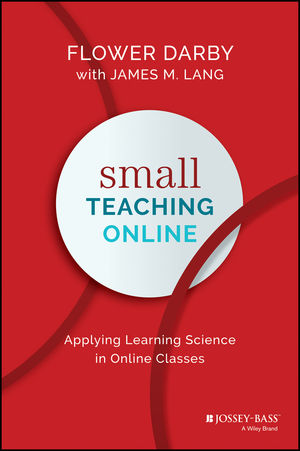The stream of “how to teach online” books and materials to support those faculty who are teaching online. I enjoy these. They are increasingly aligned with what we know about learning (and we know much more than my teachers did… we know more than any teachers did even 10 years ago). One of the great things about being a professional in the 21st century is that one can purchase books during keynote and other presentations at conferences–it is the bibliophile’s equivalent of live tweeting during the sessions. At the last conference session I attended this summer, I purchased Small Teaching Online (Darby & Lang, 2019).
The organization taken by the authors is one that if familiar to me. The “what, why, how” organization is one that I adopted around 2000, and it has been the focus of positive feedback form my students for two decades. One of the permanent problems facing authors who write about teaching is that there are so many variables that can be “tweeked” when teaching and there are so many definitions of what might be teaching and learning. This can result is one of two things. Either the book becomes too long and convoluted to be useful (due to the complexity of the field) or the book focuses on “best practices” which are dubious and distracting from what really facilitates learning.
Darby and Lang do walk the line between these potential outcomes in part, I find, by the organization of the text into three parts (designing for learning, teaching humans, and motivating students) and each part has three chapters. I’ve always maintained leaders and teachers should write down everything that need their attention, then reduce the list to the five most important, then take away two as teachers or leaders cannot focus on improving more than three things at a time.
This all makes the work readable and useful for teachers. They focus on the important aspects of classrooms and connections between teachers and students. The one criticism I would have of the book is each chapter moves from clear and in-depth treatment of the topic, then falls into a rapid-fire list of “how you can do this.” Those who work in technology are familiar with that method of writing… we have all seen (and probably written) blog posts on “the top x tools to do y” which then list tools, but do little to help navigate the tools to make a reasonable selection.
When I was an undergraduate student, I had two chemistry instructors, one in the fall semester and one spring semester. In the fall, the instructor spent lectures identifying concepts or problems, then giving as many examples as time allowed. We noted each quickly, then moved on to the next. In the spring semester, the instructor identified the concept or problem then gave a detailed explanation of one or two. My transcripts indicate I much preferred the one or two examples approach (which allowed me to transfer both semesters chemistry courses!).
As I read the “how” section of each chapters, I wanted to tell the authors, slow down, find a few tools or approaches that will help and describe those. Buy the book s you can take many notes in the margins and folder over pages. Your annotations will help you to understand that the authors intend and the message is important for educators to understand. Use your notes as well to begin conversations with instructional technology folks who support your work. They are likely to be able to interpret which of the myriad of ideas for how to realize improvements in your online teaching are going to be easiest to implement and most effective in your local circumstances.
Reference
Darby, F., & Lang, J. M. (2019). Small teaching online: Applying learning science in online classes (First edition). Jossey-Bass.
